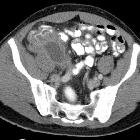mucinous neoplasms of the appendix





Mucinous neoplasms of the appendix are epithelial tumors of the appendix that produce mucin. They represent a spectrum of malignant potential, and are the most common cause of pseudomyxoma peritonei.
Pathology
Classification
According to a panel of specialists consensus published in 2016 (Peritoneal Surface Oncology Group International), a nomenclature and classification for the appendiceal mucinous neoplasms based on histologic type and biologic behavior has been proposed :
Premalignant
These lesions have no capacity to cause pseudomyxoma peritonei:
- appendiceal adenoma - tubular, tubulovillous, and villous subtypes
- serrated appendiceal polyp
Uncertain malignant potential
- low-grade appendiceal mucinous neoplasm (LAMN)
- typically do not cause nodal or distant extraperitoneal metastases
- high-grade appendiceal mucinous neoplasm (HAMN)
Malignant
- appendiceal mucinous adenocarcinoma
- poorly differentiated (mucinous) adenocarcinoma w signet ring cells - ≤50% signet ring cells
- (mucinous) signet ring cell carcinoma - >50% signet ring cells
It is important to note that in cases of peritoneal spread, the histologic grade of the peritoneal disease may be different than the primary appendiceal tumor. In these case, the peritoneal histology is considered more important for prognostication .
Radiographic features
On imaging, they are difficult to be distinguished from each other, particularly when comparing the low- and high-grade appendiceal mucinous neoplasms, and generally are referred to as a "mucinous neoplasm of the appendix".
Treatment and prognosis
Management varies depending both on the type of appendiceal tumor and (often more importantly) on the histology and extent of peritoneal disease. Surgical approaches, particularly for newer categories of disease (e.g. HAMN) remain under investigation .
In general, premalignant mucinous appendiceal tumors are treated by surgical resection. Indeterminate-behavior lesions such as LAMN are often followed with surveillance imaging after resection. Adenocarcinoma is generally treated with right hemicolectomy and nodal dissection, due to improved survival compared to appendectomy alone .
Patients with peritoneal disease (i.e. pseudomyxoma peritonei) may be treated by cytoreductive surgery with hyperthermic intraperitoneal chemotherapy (HIPEC), particularly if peritoneal disease is low-grade .
Siehe auch:
- Pseudomyxoma peritonei
- perityphlitischer Abszess
- Mukozele der Appendix
- muzinöses Zystadenom der Appendix
- Tumoren der Appendix
- muzinöses Zystadenokarzinom der Appendix
und weiter:

 Assoziationen und Differentialdiagnosen zu muzinöse Neoplasien der Appendix:
Assoziationen und Differentialdiagnosen zu muzinöse Neoplasien der Appendix:



